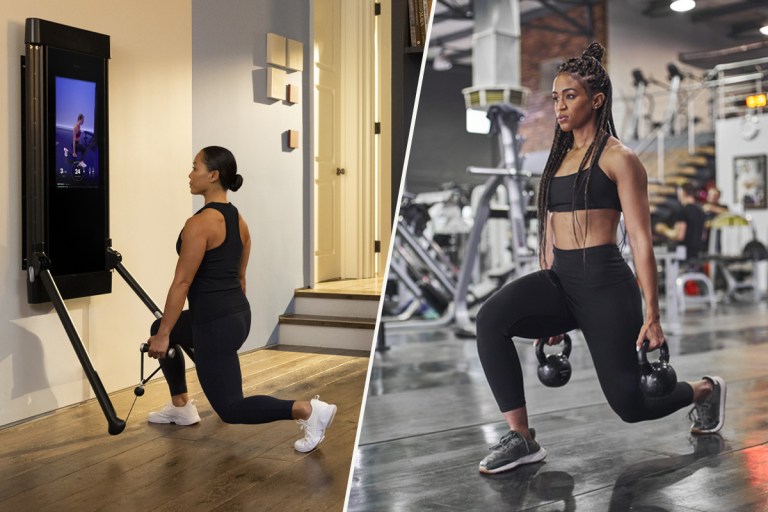Build Muscle and Rev Your Metabolism With Lean, Mean, Athletic Strength
Get bigger, stronger, and faster with a combination of foundational compound lifts and explosive plyometric bursts in this new four-week program

By Jonathan Flicker
Every time you do a coach-led workout on Tonal, you’re completing a specific series of exercises in a particular order designed to maximize your results. In this series, The Why Behind the Workout, we break down the science behind a particular workout or program.
Here, we go deep on Lean, Mean, Athletic Strength with Tonal coach and certified personal trainer Kendall “Woody” Wood.
Who It’s For
Lean, Mean, Athletic Strength is an intermediate-level program designed for the everyday athlete who wants to build foundational strength and muscle while losing fat and shifting their body composition.
Getting all of these results in just one program isn’t easy, but Wood explains, “we’re doing that by way of foundational compound lifts and movement patterns in higher rep schemes with lighter weights, then weaving in plyometric bursts and off-Tonal intervals.”
This program is a great choice for someone who used to play sports and still loves to challenge their athleticism, the weekend warrior who dabbles in recreational activities with friends, or anyone who wants to bring out their inner athlete.
“Lean, Mean, Athletic Strength, is a great program to tap into for people who want to push their limits and have the goals of getting lean and shaping up,” Wood says.
How It Works
In this program, Wood uses a combination of traditional strength training and plyometrics over four workouts per week: an upper-body day targeting chest and back, a lower-body day, a second upper-body day working the shoulders and core, and then a full-body day.
In weeks one and two, you’re establishing proficiency in the movement patterns before you progress in terms of level and complexity in weeks three and four. The idea is to progressively overload the muscles and stimulate adaptation.
“To move the needle, we need to have novel stimulus of progressive overload every couple of weeks,” says Jenna Moore, a certified strength and conditioning coach and Programming Specialist at Tonal. “The plyometric nature of the program stimulates fast-twitch muscle fibers to create the bigger, faster, stronger aesthetic and mentality.” She adds that the compound lifts are done at a moderate rep range of 8-10 reps to build muscle.
In each workout, the purpose of the first block is preparation, with movement variations that are slightly less intense to prime your body for the bigger, more technical movements you’re going to see later on. Think of it as an extended warmup.
The moves in the second (primary) block feature big compound lifts. In the first two weeks, those main movements are accompanied by active recovery exercises to give you additional time to rest, but in weeks three and four, it’s game on; they’re paired with explosive plyometrics with similar mechanics creating what is known as contrast sets. “Super-setting two movements of the same muscle group in this manner increases our force production and subsequent muscle growth,” says Wood.
The third and final block of each workout is all about cranking up your metabolism with more cardio and conditioning movements to improve agility, coordination, and explosiveness. This is when you really challenge your inner athlete, build resiliency, and strengthen the stabilizing muscles around the joints creating a more durable body.
The Key Moves
Rotational Row

Wood is a huge fan of this move along with the rotational lift and chop because, as she says, “they train the body how to transfer power and force.” These moves help you become familiar with how your kinetic chain—the interrelated group of segments within your body that work together to perform moves—functions.
Bird Dog with Row

This is a challenging move that combines two exercises, the bird dog and the single-arm row, and taps into your back, glutes, core, and shoulders. “This is a move where you need to self-correct, a term I use a lot because it empowers you and helps you notice any inconsistency in your movement pattern without me pointing it out,” explains Wood.
Barbell Hip Thrust

The barbell hip thrust is one of Wood’s all-time favorite moves because of how it isolates and strengthens the glutes from a shortened position. “Stronger glutes equals a stronger body. The stronger the glutes, the more support for the spine and the entire trunk,” she says.
Barbell Sumo Deadlift

This lower-body compound move targets the quads, glutes, hamstrings, core, and back. “We’re really tapping into the hips here,” she says, “and asking a lot from the glutes especially the glute medius,” a key muscle that stabilizes the pelvis and helps keep your trunk upright when walking or running.
When to Do it
Lean, Mean, Athletic Strength has 16 workouts designed to be completed in four weeks, with four workouts per week. “The cadence of this workout is set as on, on, off, on, off, on, off. People should fit them in when they can, but minimally getting in one or two rest days in the cycle is ideal to get full recovery,” says Moore. Wood agrees about the importance of the scheduled rest days. “You don’t want to run the risk of burning out by skipping rest days,” she says. “Listen to your body.” A typical week might look like this:

Moore says that the most important thing is consistency and setting your intentions for each day.“You will get out what you put in. If you’re looking to maximize your results, show up every workout ready to give it your all,” she says.
What to Do Next
Power Hour 2 – Coach Kendall Wood

“If your momentum is high after completing this program, you should tap into my recently released Power Hour 2,” says Wood. It uses the same general idea of incorporating the most fundamental compound lifts and maximizing your power by pairing them with off-Tonal plyometrics. “It will be a fun test of how far you’ve come and how strong you’ve gotten, but it’s not for the faint of heart,” she says.
Power Gains – Coach Tim Landicho

In this program, “The rep ranges are in the 6 to 8 range, which makes it a perfect progression from the 8 to 10 we used in Lean, Mean, Athletic Strength,” says Moore. It utilizes the Bulgarian Method to build strength and power. This method uses Eccentric and Chains mode to vary between slower, more controlled, and faster, more dynamic reps of the same movement.



